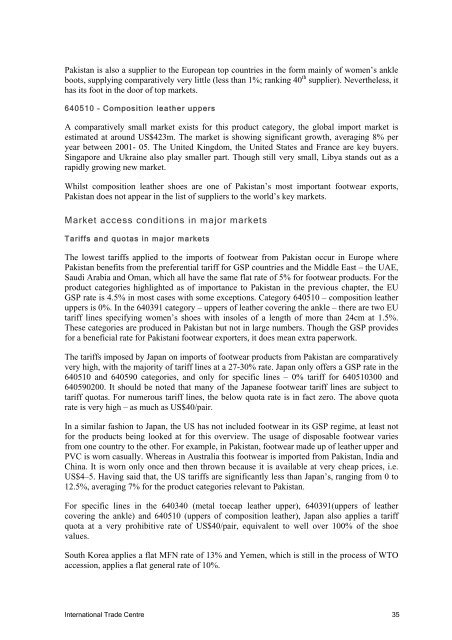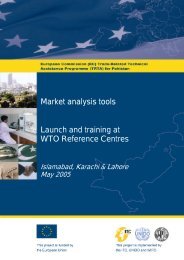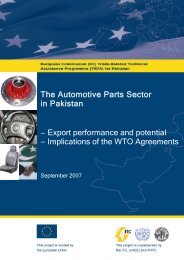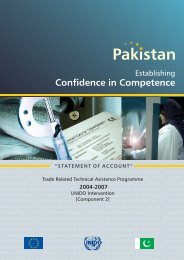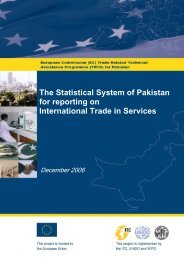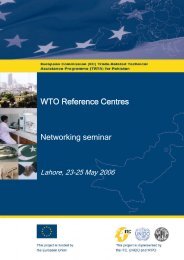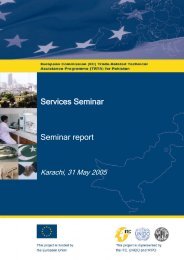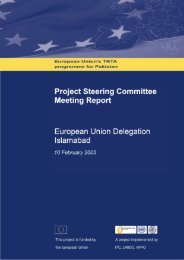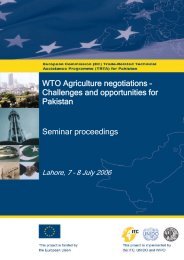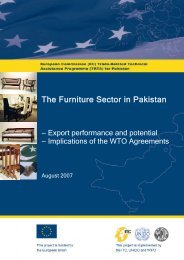The Sports Goods Sector in Pakistan - TRTA i
The Sports Goods Sector in Pakistan - TRTA i
The Sports Goods Sector in Pakistan - TRTA i
Create successful ePaper yourself
Turn your PDF publications into a flip-book with our unique Google optimized e-Paper software.
<strong>Pakistan</strong> is also a supplier to the European top countries <strong>in</strong> the form ma<strong>in</strong>ly of women’s ankleboots, supply<strong>in</strong>g comparatively very little (less than 1%; rank<strong>in</strong>g 40 th supplier). Nevertheless, ithas its foot <strong>in</strong> the door of top markets.640510 – Composition leather uppersA comparatively small market exists for this product category, the global import market isestimated at around US$423m. <strong>The</strong> market is show<strong>in</strong>g significant growth, averag<strong>in</strong>g 8% peryear between 2001- 05. <strong>The</strong> United K<strong>in</strong>gdom, the United States and France are key buyers.S<strong>in</strong>gapore and Ukra<strong>in</strong>e also play smaller part. Though still very small, Libya stands out as arapidly grow<strong>in</strong>g new market.Whilst composition leather shoes are one of <strong>Pakistan</strong>’s most important footwear exports,<strong>Pakistan</strong> does not appear <strong>in</strong> the list of suppliers to the world’s key markets.Market access conditions <strong>in</strong> major marketsTariffs and quotas <strong>in</strong> major markets<strong>The</strong> lowest tariffs applied to the imports of footwear from <strong>Pakistan</strong> occur <strong>in</strong> Europe where<strong>Pakistan</strong> benefits from the preferential tariff for GSP countries and the Middle East – the UAE,Saudi Arabia and Oman, which all have the same flat rate of 5% for footwear products. For theproduct categories highlighted as of importance to <strong>Pakistan</strong> <strong>in</strong> the previous chapter, the EUGSP rate is 4.5% <strong>in</strong> most cases with some exceptions. Category 640510 – composition leatheruppers is 0%. In the 640391 category – uppers of leather cover<strong>in</strong>g the ankle – there are two EUtariff l<strong>in</strong>es specify<strong>in</strong>g women’s shoes with <strong>in</strong>soles of a length of more than 24cm at 1.5%.<strong>The</strong>se categories are produced <strong>in</strong> <strong>Pakistan</strong> but not <strong>in</strong> large numbers. Though the GSP providesfor a beneficial rate for <strong>Pakistan</strong>i footwear exporters, it does mean extra paperwork.<strong>The</strong> tariffs imposed by Japan on imports of footwear products from <strong>Pakistan</strong> are comparativelyvery high, with the majority of tariff l<strong>in</strong>es at a 27-30% rate. Japan only offers a GSP rate <strong>in</strong> the640510 and 640590 categories, and only for specific l<strong>in</strong>es – 0% tariff for 640510300 and640590200. It should be noted that many of the Japanese footwear tariff l<strong>in</strong>es are subject totariff quotas. For numerous tariff l<strong>in</strong>es, the below quota rate is <strong>in</strong> fact zero. <strong>The</strong> above quotarate is very high – as much as US$40/pair.In a similar fashion to Japan, the US has not <strong>in</strong>cluded footwear <strong>in</strong> its GSP regime, at least notfor the products be<strong>in</strong>g looked at for this overview. <strong>The</strong> usage of disposable footwear variesfrom one country to the other. For example, <strong>in</strong> <strong>Pakistan</strong>, footwear made up of leather upper andPVC is worn casually. Whereas <strong>in</strong> Australia this footwear is imported from <strong>Pakistan</strong>, India andCh<strong>in</strong>a. It is worn only once and then thrown because it is available at very cheap prices, i.e.US$4–5. Hav<strong>in</strong>g said that, the US tariffs are significantly less than Japan’s, rang<strong>in</strong>g from 0 to12.5%, averag<strong>in</strong>g 7% for the product categories relevant to <strong>Pakistan</strong>.For specific l<strong>in</strong>es <strong>in</strong> the 640340 (metal toecap leather upper), 640391(uppers of leathercover<strong>in</strong>g the ankle) and 640510 (uppers of composition leather), Japan also applies a tariffquota at a very prohibitive rate of US$40/pair, equivalent to well over 100% of the shoevalues.South Korea applies a flat MFN rate of 13% and Yemen, which is still <strong>in</strong> the process of WTOaccession, applies a flat general rate of 10%.International Trade Centre 35


